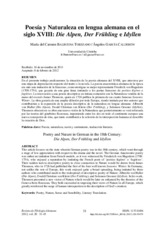Mostrar el registro sencillo del ítem
Poesía y Naturaleza en lengua alemana en el siglo XVIII: Die Alpen, Der Frühling e Idyllen
| dc.contributor.author | Balbuena Torezano, M. del Carmen | |
| dc.contributor.author | García Calderón, Ángeles | |
| dc.date.accessioned | 2018-12-03T12:34:37Z | |
| dc.date.available | 2018-12-03T12:34:37Z | |
| dc.date.issued | 2012 | |
| dc.identifier.uri | http://hdl.handle.net/10396/17550 | |
| dc.description.abstract | En el presente trabajo analizaremos la situación de la poesía alemana del XVIII, que atraviesa por una etapa de depreciación respecto del teatro o la novela. La poesía anacreóntica alemana de la época era más una imitación de la francesas, como atestigua su mejor representante Friedrich von Hagedorn (1708-1754), que gozaría de una gran fama imitando a los poetas franceses de poésies légères o fugitives. La renovación a una poesía descriptiva en íntima comunión con la Naturaleza vendría de la mano del escocés James Thomson, quien en 1726 publica la primera de sus cuatro famosas Seasons: Winter. La obra gozaría de una amplia difusión por toda Europa, siendo imitada por tres autores que contribuirían a la expansión de la poesía descriptiva de la naturaleza en lengua alemana: Albrecht von Haller (Die Alpen), Ewald Christian von Kleist (Der Frühling), y Solomon Gessner (Idyllen). Thomson ofrecerá en su obra una nueva visión de la Naturaleza que posteriormente se verá reforzada por las teorías del ginebrino Rousseau, imponiendo entre los dos en todo el continente europeo una nueva concepción de ésta, que tanto contribuirá a la eclosión de la introspección humana al describir la creación de Dios. | es_ES |
| dc.description.abstract | This article focuses on the state wherein German poetry was in the 18th century, which went through a stage of low appreciation with respect to the drama and the novel. The German Anacreontic poetry was rather an imitation from French models, as it was witnessed by Friederich von Hagedorn (1708- 1754), who enjoyed a reputation by imitating the French poets of ‘poésies légères’ o ‘fugitives’. Their sudden turn to descriptive poetry in close connection to Nature would be drawn from James Thomson, who in 1726 had published the first of his four well known Seasons: Winter. In Germany, not unlike the rest of Europe, this work enjoyed quite a broad spreading, being imitated by three authors who contributed much to the widespread of descriptive poetry of Nature: Albrecht von Haller (Die Alpen), Ewald Christian von Kleist (Der Frühling), and Solomon Gessner (Idyllen). In his work, Thomson presented a new vision of Nature which would be later on enhanced by the theories of the Geneva-born Rousseau. They both succeeded in imposing their views of Nature in all Europe, which greatly reinforced the surge of human introspection in the description of God’s creation | es_ES |
| dc.format.mimetype | application/pdf | es_ES |
| dc.language.iso | spa | es_ES |
| dc.publisher | Universidad Complutense | es_ES |
| dc.rights | https://creativecommons.org/licenses/by-nc-nd/4.0/ | es_ES |
| dc.source | Revista de Filología Alemana 20, 31-45 (2012) | es_ES |
| dc.subject | Poesía | es_ES |
| dc.subject | Naturaleza | es_ES |
| dc.subject | Razón y sentimiento | es_ES |
| dc.subject | Traducción literaria | es_ES |
| dc.subject | Poetry | es_ES |
| dc.subject | Nature | es_ES |
| dc.subject | Sense and Sensibility | es_ES |
| dc.subject | Literary Translation | es_ES |
| dc.title | Poesía y Naturaleza en lengua alemana en el siglo XVIII: Die Alpen, Der Frühling e Idyllen | es_ES |
| dc.title.alternative | Poetry and Nature in German in the 18th Century: Die Alpen, Der Frühling and Idyllen | es_ES |
| dc.type | info:eu-repo/semantics/article | es_ES |
| dc.relation.publisherversion | http://dx.doi.org/10.5209/rev_RFAL.2012.v20-39179 | es_ES |
| dc.rights.accessRights | info:eu-repo/semantics/openAccess | es_ES |

